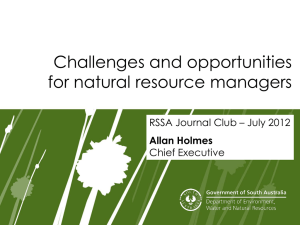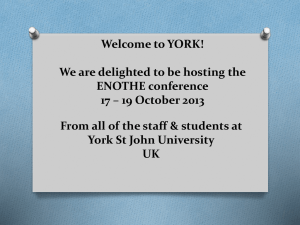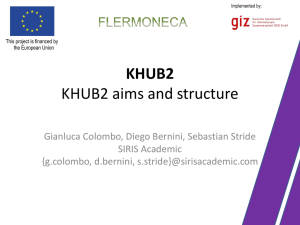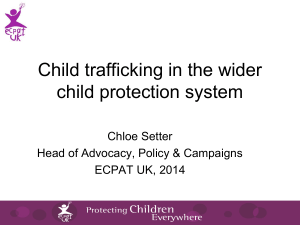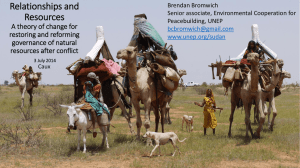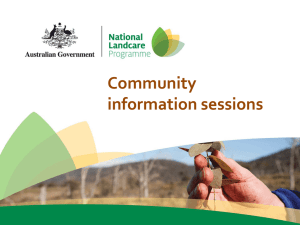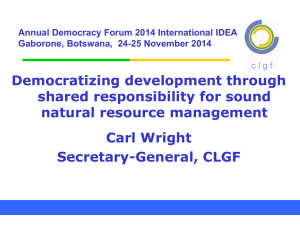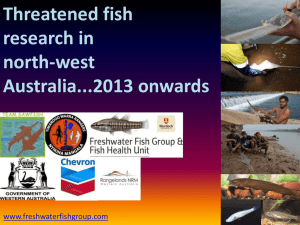National-Scale Governance of Australia`s Community Based NRM
advertisement
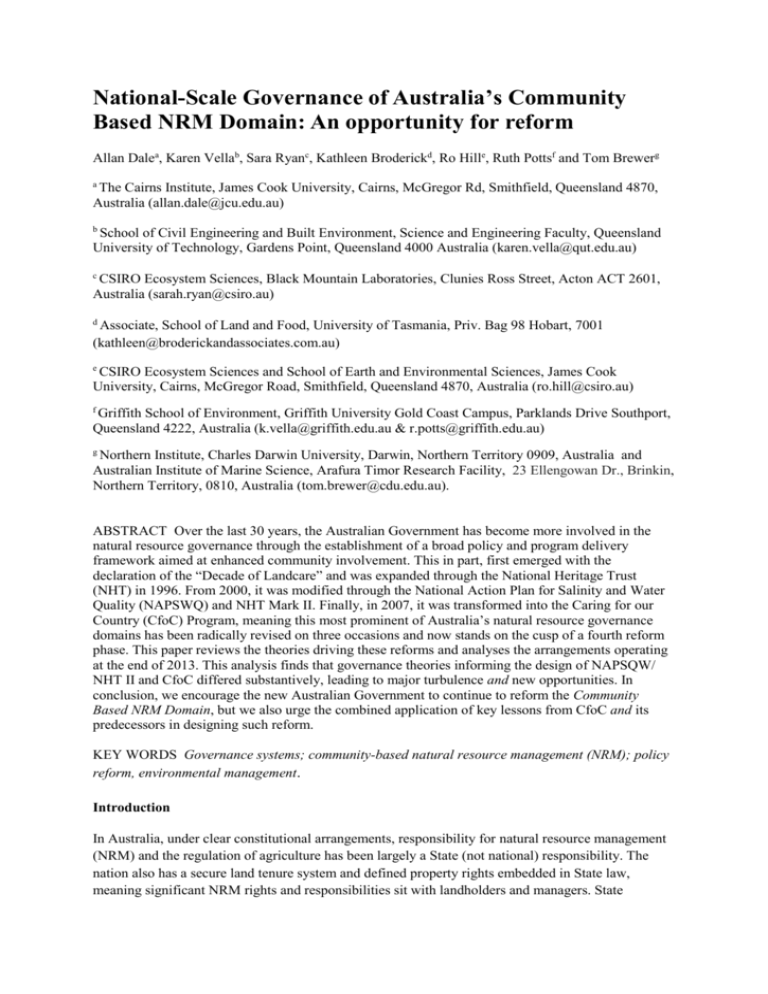
National-Scale Governance of Australia’s Community Based NRM Domain: An opportunity for reform Allan Dalea, Karen Vellab, Sara Ryanc, Kathleen Broderickd, Ro Hille, Ruth Pottsf and Tom Brewerg a The Cairns Institute, James Cook University, Cairns, McGregor Rd, Smithfield, Queensland 4870, Australia (allan.dale@jcu.edu.au) b School of Civil Engineering and Built Environment, Science and Engineering Faculty, Queensland University of Technology, Gardens Point, Queensland 4000 Australia (karen.vella@qut.edu.au) c CSIRO Ecosystem Sciences, Black Mountain Laboratories, Clunies Ross Street, Acton ACT 2601, Australia (sarah.ryan@csiro.au) d Associate, School of Land and Food, University of Tasmania, Priv. Bag 98 Hobart, 7001 (kathleen@broderickandassociates.com.au) e CSIRO Ecosystem Sciences and School of Earth and Environmental Sciences, James Cook University, Cairns, McGregor Road, Smithfield, Queensland 4870, Australia (ro.hill@csiro.au) f Griffith School of Environment, Griffith University Gold Coast Campus, Parklands Drive Southport, Queensland 4222, Australia (k.vella@griffith.edu.au & r.potts@griffith.edu.au) g Northern Institute, Charles Darwin University, Darwin, Northern Territory 0909, Australia and Australian Institute of Marine Science, Arafura Timor Research Facility, 23 Ellengowan Dr., Brinkin, Northern Territory, 0810, Australia (tom.brewer@cdu.edu.au). ABSTRACT Over the last 30 years, the Australian Government has become more involved in the natural resource governance through the establishment of a broad policy and program delivery framework aimed at enhanced community involvement. This in part, first emerged with the declaration of the “Decade of Landcare” and was expanded through the National Heritage Trust (NHT) in 1996. From 2000, it was modified through the National Action Plan for Salinity and Water Quality (NAPSWQ) and NHT Mark II. Finally, in 2007, it was transformed into the Caring for our Country (CfoC) Program, meaning this most prominent of Australia’s natural resource governance domains has been radically revised on three occasions and now stands on the cusp of a fourth reform phase. This paper reviews the theories driving these reforms and analyses the arrangements operating at the end of 2013. This analysis finds that governance theories informing the design of NAPSQW/ NHT II and CfoC differed substantively, leading to major turbulence and new opportunities. In conclusion, we encourage the new Australian Government to continue to reform the Community Based NRM Domain, but we also urge the combined application of key lessons from CfoC and its predecessors in designing such reform. KEY WORDS Governance systems; community-based natural resource management (NRM); policy reform, environmental management. Introduction In Australia, under clear constitutional arrangements, responsibility for natural resource management (NRM) and the regulation of agriculture has been largely a State (not national) responsibility. The nation also has a secure land tenure system and defined property rights embedded in State law, meaning significant NRM rights and responsibilities sit with landholders and managers. State statutory soil conservation approaches first emerged in the States of Western Australia (WA) in the 1940s and Victoria in the 1960s (Ewing 2003). From the 1970s, however, the environmental impacts of State-driven developmentalism elevated environmental issues like urban and industrial water and air pollution. With the Federal Government passing the Environmental Impact Assessment Act in 1974, State approaches to dealing with NRM problems remained focused on compliance-oriented regulation (van Oosterzee et al. 2012). For historical, equity and biophysical reasons, these regulatory approaches were not easily transferrable to rural landscapes, industries and communities (Bates 2010). Over the same period, the nation’s landholders were starting to collectively embrace more local resource stewardship (Lockie & Vanclay 1997; Prager & Vanclay 2010; Curtis et al. 2014). A ground-breaking National Soil Conservation Program was established in 1983 to provide leadership in the management of land degradation issues and to boost state activities (Curtis et al. 2014). The Landcare movement later saw both the conservation and farming sectors strike a national accord in the late 1980s, leading to the first major Australian Government investment via national, grant-based funding under the ‘Decade of Landcare’ (1990-1999). Over time, Landcare expanded from being a landholder movement to one representing other forms of local collective action, including Bushcare, Coastcare, Waterwatch, Indigenous Land and Sea Management and similar grass-roots action groups. Some sense of the need for regional or catchment scale coordination of these regulatory and/or voluntary activities began developing within individual states from the 1980s via the emergence of Integrated Catchment Management (ICM) groups (Lockie & Vanclay 1997). The form and purpose of these groups varied widely across the nation, with a key theme being the need for the development and implementation of integrated catchment management plans to coordinate on-ground action. In another major development, recognition by the High Court in 1992 of native title rights intersected with State-based tenure and property rights systems, and Indigenous rights and interests in land became recognised to varying extents over more than half the continent (Hill et al. 2013). This in itself was the precursor to a more direct Commonwealth interest in Indigenous land and NRM issues. With a new Coalition Government coming to power nationally in 1996, the momentum established under the ‘Decade of Landcare’ was translated into a new national grants based program, the Natural Heritage Trust (NHT). This program was funded through the sale of Telstra (a government-owned telecommunications company) and became a significant, nationally-competitive grants program. While NHT was given effect through financially-oriented legislation (the Natural Heritage Trust Act), it did not sit within a cohesive or bilateral NRM policy framework and it paid limited attention to the necessarily multi-scalar nature of natural resource governance. At the national scale, wider crosssectoral involvement was, however, managed via a NHT Advisory Council. While no substantive governance-based policy analysis led to the formation of the NHT, the program raised the profile of community based NRM and the nation’s awareness of NRM issues (Hassall & Associates 2003). Fragmented and incomplete regulatory and weak grant-based approaches across the 1980s and 1990s, however, failed to address several latent NRM crises in the Australian landscape (van Oosterzee et al. 2013). At the same time, state-based regulatory approaches were increasingly leading to declining trust in governments among rural communities (Productivity Commission 2003). Consequently, a more theoretically informed shift in natural resource governance emerged (National Natural Resource Management Policy Statement Steering Committee 1999; Robins et al. 2007), leading to the Australian Government becoming more involved in multi-scalar aspects of NRM. The shift aimed to secure a move from geographically (e.g. State by State) and sectorally (e.g. water versus biodiversity) fragmented approaches to a spatially integrated national framework (Dale et al. 2008). The emergence of a national policy framework for community based NRM From 2001 onwards (see van Oosterzee et al. 2013 for details), formally negotiated bilateral arrangements between the Commonwealth and the states spearheaded reforms in Community-Based NRM (CBNRM). For the purposes of this paper, we concur with Curtis et al. (2014) and Berkes (2005, p. 41) in regard to the definition of CBNRM as ‘shorthand for governance that starts from the ground up but deals with cross-scale interactions’. These arrangements recognised the multi-scalar realities of natural resource governance. Regional NRM bodies were established to develop and maintain regional NRM plans (Paton et al. 2004) to guide more localised action. The planning process was to secure regional consensus on aspirational and (nationally guided) resource condition targets. Investment and effort mobilisation strategies were designed to motivate land holders and other natural resource managers to improve management practices. Consequent programs and projects (devised at cross-regional, regional, catchment and local scales) were delivered by partner organisations such as Landcare groups, traditional owners, industry bodies, environment groups, councils or consultants. While a substantive governance innovation, these efforts, however, were not always delivered evenly across different sectors and over all geographic scales (e.g. see Hill et al. 2013). Due to a policy bias and differing regional capacities, slower progress was made in the engagement of Indigenous and conservation interests. At the same time, rather blunt bilateral negotiations tended to see some parts of the national landscape under-resourced (e.g. central Australia). On the whole, however, all land holders in most regions across the nation, for the first time, were able to elect to become part of the NRM process via extension, training and incentive-based activities. Collaborative projects were encouraged and stable funding or other resources were often provided to implement priority actions. At the foundation regional scale and under the bilateral agreements, regional NRM bodies were designated by States and the Commonwealth on the basis of their demonstrated capacity to undertake strategic planning, deliver effective programs and to engage the regional community in plan development and implementation (van Oosterzee et al. 2012; Dale et al. 2013a). Regional NRM plans were jointly accredited by the State and Commonwealth and comprised scientifically informed, but regionally negotiated targets and priorities, including time-bound Resource Condition Targets and associated Management Action Targets (Dale et al. 2013a). Between 2001 and 2007, while these new regional arrangements unfolded, continuing improvements in the capacity of land holders and key sectors across the nation emerged (Robins & Dovers 2007). With their extensive land holder networks, regional NRM bodies (with their delivery partners) provided the technical and facilitative services for sustainable NRM needed by land holders (but were impacted by the nationwide retreat from State-provision of extension services). Because they were often trusted more than government workers (Marshall 2009), regional NRM bodies became a key source of NRM knowledge, advice, funding and support for landholders. They were also an integrative point for the management of assets (such as water, biodiversity, soils and carbon) and threats (e.g. weed and feral animal management, climate change and variability, and salinity). Essentially, NRM carried out at the regional scale and guided by these consensus-driven regional NRM plans began contributing to sustainable regional and rural development by integrating economic, social and environmental policies via on-ground implementation (Williams et al. 2005). The regional bodies, to varying degrees of capacity, had the required deep reach into the catchment, local government, landcare and landholder-based delivery systems required to achieve complex project management and on the ground outcomes. Regional bodies were also able to report effectively in a nationally consistent way on progress towards the achievement of targets. Integration with wider regional economic and social development and land use planning processes was also encouraged. Such arrangements enabled the scaling up of solutions to cross-regional problems (Dale et al. 2013a). By 2007, the implementation of this new national framework, while still experimental and with varying strengths and weaknesses across different regions (Lane et al. 2009), had generally resulted in a shift towards more devolved regional approaches with better integration of NRM objectives in the landscape. A recent review of CfoC by the Australian Government also acknowledged that regional bodies had been effectively building and maintaining relationships with local groups (Australian Government 2012). The theory-based governance innovation applied from 2000 to 2007, however, was the policy recognition that regional NRM approaches take a longer-term, target-focused, landscape-scale perspective, in contrast with, and complementary to, past regulatory regimes. The CfoC shift from multi-scalar regionalism The new Labor Australian Government in 2007 undertook reforms that shifted the policy-centricity of governance arrangements in CBNRM. These reforms were driven by the National Audit Office finding that that there was little recorded evidence that the nation’s natural resource condition had improved through multi-billion dollar investment (Australian National Audit Office 2008). It was also perceived the NAPSWQ/NHT arrangements had excluded Indigenous land managers, biodiversity and environmental groups, while privileging the agricultural sector. Reforms introduced opportunities for other organisations to compete for funds at different scales, undermining the devolved regional model (Robins & Kanowski 2011). Second, the previous national framework to guide regional targetsetting was replaced with a set of national targets to guide project development. National-State bilateral agreements, which had levered State investment and coordinated effort, were discontinued. The consequent new CfoC Program swung away from supporting a regional framework capable of tackling complex cross-sectoral problems at regional scale (Robins 2010) to an approach focused on a range of tailored but fragmented national investments (Commonwealth of Australia 2012). While successfully integrating a number of separate Australian Government programs, the framing and delivery of the new CfoC program re-centralised control; reducing its focus to short-term, measureable outputs (Robins & Kanowski 2011). Base-level funding, which allowed regional bodies to function and deliver stable outcomes, was left uncertain and then cut by 40% (van Oosterzee et al. 2013). The remaining CfoC funds were then competitively allocated to small and large groups and individuals who, under the regional framework, had previously been working collaboratively to help manage complex problems. Previously less engaged groups (Indigenous and environment groups) and region’s less favoured by blunt bilateralism (e.g. Central Australia), however, did become more engaged. There was also a stronger focus on the development of a National Reserve System and new players (e.g. the Pew Foundation and The Nature Conservancy) increased their national influence. The 2009-10 CfoC round of competitive grants resulted in 1300 proposals nationally, of which 59 were successful: a success rate of 5% (and 1% for regional bodies). Consequently, many stakeholders found themselves heavily disengaged and restricted to annual grant systems (Robins 2010; Robins & Kanowski 2011). Further, from 2008 to 2012, the influence of regional NRM plans was substantively marginalised, despite past community effort and cost (Robins 2010). Instead of facilitating strategic and continuous improvement, the Australian Government view was that it had “shifted away from investment in a complex regional accreditation framework” (Caring for our Country Review Team 2012, p. 9). The peak regional NRM body, the Regional NRM Chairs, was left to express concern that the relationship between the Commonwealth and the regions had been altered with little shared discussion about options for continuous improvement (Ryan et al. 2010). While the broader CfoC framework eschewed devolved, polycentric approaches as a core tenet, some CfoC sub-programs adopted more centralised forms of devolved effort. The Indigenous Protected Areas sub-program, for example, provided devolved funds to traditional owner groups to plan the declaration and management of new Indigenous Protected Areas (IPAs). This planning funding was followed up with long term delivery contracts through the Working on Country (WoC) sub-program. These CfoC sub-programs were also managed by a dedicated team of centrally-based sub-program specialists with significant operational flexibility. Consequently, Indigenous groups across northern Australia made real gains in capacity and delivery as a result. Similarly, the Reef Rescue subprogram, arguably CfoC’s most high profile success, was also negotiated by regional NRM, industry and conservation bodies ahead of the main CfoC framework. Governance innovations established under NAPSWQ/NHT, however, had helped drive the evolution of these sub-programs. After several years of CfoC operation and at odds with CfoC’s shift away from the role of regional NRM plans, the Commonwealth’s Clean Energy Future (CEF) plan, developed via another agency, revived the use the use of regional NRM plans, enabling them to play a central role in the delivery of NRM and climate adaptation. The plans were now seen as a productive, effective way of planning to prioritise investment in Australian landscapes (DSEWPaC 2012). The CEF included a wide range of activities which would support not only the reduction of emissions and new renewable technologies, but new ways of thinking about securing landscape resilience and managing/storing carbon in Australian landscapes. In particular, the CEF allocated some $1.7 billion to facilitate land sector greenhouse gas abatement, including $44 million to revitalise the nation’s regional NRM plans so that they could support landscape scale adaptation and guide the emergence of the nation’s land-sector based carbon market, particularly under the Carbon Farming Initiative or CFI (Dale et al. 2013a). Governance theory and domain reform In summary, Table 1 outlines governance theories, including theories of devolution, multi-scalar polycentric governance and institutional linkages that have informed major national reforms underpinning the history of Australia’s Community Based NRM Domain. Consistent with terminology adopted by Dale et al. (2013b), the Community Based NRM Domain refers to all aspects of Australia’s system of CBNRM governance, from national to local scales. Table 1: The role of governance theory in different CBNRM Domain Reforms Key Phase Decade of Landcare (1980s) Informing Theory Community participation. Integrated catchment management. Land stewardship. Natural Heritage Instrumental devolution. Role of Governance Theory Reforms were based on an emerging national sentiment of land stewardship, backed by both the Australian Conservation Foundation (ACF) and the National Farmers Federation (NFF). These sentiments were also backed by an emerging governance literature on land stewardship, community based-NRM and integrated catchment management. There was, however, a limited global theoretical analysis of national policy solutions to NRM problems. Popular political support for Federal fundingbased investment in land stewardship informed Key Documents Curtis & Lockwood (2000). Toyne & Farley (2000). Natural Heritage Trust Trust (late 1990s) NAPSWQ and NHTII (20002007) Land stewardship. Bilateral administrative governance. Instrumental devolution. Systemic and adaptive governance. CfoC (200720013) Public sector centralisation. Program Reporting and Program Logic. Sector specific instrumental devolution. the emergence of the NHT agenda, rather than structured governance theory. There was limited global theoretical analysis of policy solutions to national-scale NRM problems. The reform was based on the theory that devolution to local-scale led to improved NRM outcomes (Berkes 2005). The NHT Mid Term Review documented and explored the wider NRM issues facing the nation and outlined the limits of small grants. This led to the Commonwealth Blue Book, and recognition that local-scale devolution was insufficient. It was considered that a cohesive and systemic set of national policy reforms was required. This work drew upon emerging NRM governance theories about multi-scalar governance (see Hill et al. 2010) by providing a national framework for regional target setting. A new Labor Government responded to advice from the Office of Audit that outcomes against inputs had not been well measured in NHT II and NAPSWQ. They responded by reforming the multi-scalar governance system: changing the national element from providing a framework to target setting and by reforming the regional element to allow competition for the regional governance mandate. This saw significant developments in devolved Indigenous governance and a stronger focus on biodiversity and the National Reserve System. Act. Environment Australia (1998). Mid Term NHT Review (Dames & Moore 1999). The C’wealth Blue Book (NNRPSSC 1999). The Keogh Review (Keogh et al. 2006). National Audit Office Assessment of Regional Delivery ANAO (2008). Inquiry into NRM and Conservation Challenges (SRRATRC 2010). The new Coalition-based Australian Government is now set to exert another phase of reformist influence upon the Community-Based NRM Domain; perhaps the fifth in its short history. Early indications suggest a Governmental intent to enhance devolved regionalism, to continue to retain the link between landscape-scale greenhouse gas abatement and strategic regional priorities, and to refocus effort back at regional and local scales (Neales 2013). As such, the balance of this paper applies governance theory (via a structural-functional approach to analysis) to review the health of the domain as it stood at the end of 2013 and to explore key priorities for the next phase of reform. Methods A systemic governance analysis framework was applied, inclusive of the steps devised by Dale et al. (2013b) for defining priority governance domains and sub-domains at risk of failure within any particular governance system. This analysis frame was applied to Australia’s Community Based NRM Domain of governance (referred to from here as the CBNRM Domain). The approach brought together researchers and practitioners with a wide skills base in respect to community-based natural resource governance within Australia. The research team undertook the analysis through structured focus group workshops during late 2013 and 2014, followed by written feedback from process participants and other NRM practitioners over a six month period. This involved working through a 3-step process. Step 1: Describing the system’s structural and functional characteristics Dale et al. (2013b) outline the need to explore the structural (vision and objective setting, research and assessment, strategy development, implementation and monitoring, evaluation and review) and functional (decision capacity, connectivity and knowledge use) aspects of any governance system. Hence our first team workshop drew on the experience and knowledge of the team’s members and the literature to populate a preliminary matrix describing the structural and functional aspects of governance for the CBNRM Domain. Through a delphi-style approach, the matrix was refined via outof-session drafting. Applying this descriptive approach to key aspects of governance in the CBNRM Domain set the foundations for the application of consistent evaluative principles in Step 2. Describing the structural and functional aspects of the nation’s CBNRM Domain in this way also enabled the scoping of the most fruitful lines of further analytical inquiry needed to effectively assess the health of the current system in Step 2. Drawing upon a wide range of knowledge sources through team workshops and a detailed literature review enabled us to consolidate systemic knowledge about the domain which helped facilitate detailed analysis by our focus groups and other inputs in Step 2. Step 2: Applying a common set of evaluative principles Building on Step 1, we applied a robust set of seven core evaluative criteria (consolidated from UNDP 1997; Dale & Bellamy 1998; OECD 2004; Ryan et al. 2010) to draw out results concerning the structural and functional health of the domain. These evaluative criteria included the sustainability, equity, accountability, adequacy, effectiveness, efficiency and adaptability of governance. These criteria were applied to the analysis of data collected against all lines of inquiry in Step 1. Several research tools were applied to enhance this analysis: Detailed team discussion and collaborative writing; Two focus group exercises involving regional NRM planners, program specialists and former Government employees from across Australia’s and Queensland’s NRM sector; Specific feedback and analytical review from specialists in the Indigenous and conservation sectors, enabling a wider basis for analysis of the current governance arrangements; The integration of results from previous evaluative work undertaken with Chairs and CEOs of NRM bodies across the nation and via regional case studies in Far North Queensland and Tasmania (see Ryan et al. 2010 and Dale et al. forthcoming); and Targeted review of emerging materials/data from other experts in the CBNRM Domain. Through these linked processes, and through the guiding application of these evaluative criteria, we were able to undertake a deeper, more consistent analysis of structural and functional elements of the system. The analysis results are later outlined in some detail in Table 2. Step 3: Building recommendations as a basis for reform Working through Steps 1 and 2 of this framework provided a basis for the research team crafting the key reforms outlined in the discussion with respect to the governance of the overall system comprising the nation’s CBNRM Domain. We did this through both expert consideration and participant discussion with focus group members and via research team meetings, while constantly referring back to both participant knowledge and the theory/practice literature on governance reform. Results Based on the outputs from Steps 1 and 2, structural and functional strengths and weaknesses of the nation’s CfoC-dominated CBNRM Domain as of late 2013 are summarised in Table 2. To set the context for the results of this review, however, it is worth noting that the national 20 year resource condition outcomes articulated for CfoC were general and operationalized through the annual CfoC Business Plan that represented narrow programmatic targets versus policy-oriented national resource condition targets. Over the same time, a continuing national decline in resource condition and trend has been identified via the nation’s State of the Environment reporting system (SoE 2011 Committee and see also DSEPaC 2008). These wider national-scale landscape outcomes are the focus of this analysis of the country’s CBNRM Domain, rather than a narrow evaluation of the CfoC Program. Table 2: A synthesis of findings from the application of GSA to national aspects of Australia’s CBNRM Domain as of late 2013. Structures and suggested reform priorities for structural components Visioning and objective setting: Critical need to for a revised bi- or tri-lateral framework for inter-governmental agreement, but needs to be mindful of distributional equity. Policy design needs explicit linkage back to long term resource condition monitoring. Clearer policy-oriented engagement frameworks need to be established with key national sectors. Independent institutional focus on working with all levels of government to continually improve the health of the CBNRM Domain. Research and analysis: Explore re-establishment of integrated NRM knowledge brokerage and audit institutions at national, State and regional scales. Enhance place-based approaches to knowledge brokerage and research delivery across Australia. Ensure governance-based research components are partnered with any major biophysical, social and economic research programs and projects. Strategy development: CBNRM Domain lead agencies should explore a wider range of strategy options to achieve goals. Stronger national support for regional NRM plans and institutional capacity of regional NRM bodies. Both the Commonwealth and State progress cohesive, simple regional NRM body designation/plan accreditation systems. Continue governance reforms in regions to ensure Decision making capacity Functions Connectivity NHT Act continues to establish legal architecture for funding, but does not establish a policy vision. Vision for overall community-based NRM agenda appears focused on program vs. policy targets. Public sector (Commonwealth/State) capacity for informed/ independent national policy development appears to be declining, including a loss of corporate knowledgei. Key sectoral institutions at policy level have variable corporate continuous improvement systems, limiting capacity to influence policy. No framework for bilateral policy and priority agreement with State agencies and Local government. Little structured engagement with agencies responsible for other Commonwealth NRM domains and other governance domainsii. No framework for structured agreement among key sectors regarding vision and objectives. Program visioning has been reduced to an annual (outputsbased) CfoC Business Plan based on weak sectoral engagement; ignoring CBNRM principlesiii. Integrated NRM knowledge broker and investor (Land and Water Australia or LWA) dismantled. Foundations of an integrated Land and Water Audit dismantled. Less capacity in national systems in place for research synthesis, scoping and knowledge retention. Few cohesive State or regional systems for NRM research synthesis, scoping and knowledge retentioniv. Domain only operates on one central national strategy: the delivery of a competitive grants round, suggesting limited strategy development capacity. Diminished and unclear investment in regional NRM bodies and removal of designation arrangements diminished strategic regional and local NRM planning capacity. Key Land and Water Audit style functions fragmented back to different agencies (e.g. BOM). Poor connectivity among various national, state and regional research and development frameworks relevant to NRM. Some attempt to rebuild regional knowledge linkages to regional NRM plans via Stream 2 Cluster investments for climate change. Singularised (grants) strategy has been developed in significant isolation from other national NRM governance domains. Now limited connectivity between national strategy with State, regional or local strategic planning. Potential interface between land use planning and NRM diminished. Poor integration between market, Knowledge use Vision and objective setting has become less-connected with any national integrated knowledge base (e.g. the Land and Water Audit) and knowledge broker (e.g. LWA). No cohesive R&D strategy is in place to inform policy vision and objective setting at national and state scales, but now stronger at regional scale through investment in cluster-based collaborative arrangements. No independent institution with research and knowledge capacities exists to agitate for cohesive and ongoing systemic reform. Nation has strong biophysical knowledge sets to underpin decision making in this domain. Limited structured use of social sciences and resource condition and trend data across the domain. Cultural and historical knowledge sets generally poorly integrated. Shift to outputs-based reporting has failed to match ANAO concerns re lack of outcomes monitoring. Little governance and social research underpins strategy development and review. Some strong practical knowledge applied in design of more devolved sub-programs like IPA, WOC and RR. Governance theory informed development of CFI strategy and revitalisation of regional plans. representative engagement and continuous improvement for regional NRM planning/review. Retain and strengthen IPA and WOC sub-programs and reinstitute bilaterally agreed national, state, cross-regional and regional investment streams. Some strategic regional NRM capacity returned via CFI-oriented investment in Stream 1 funding for next generation regional plansv. regulatory and suasive strategies. Emerging but limited connectivity with CFI market strategy, but effort fragmented across agencies. Implementation: Annual program cycle diminishes the capacity of on-ground agents, with low levels of application success. Capacity for deciding grants is centralised, with limited ability to judge quality in regional context. Despite improving capacities, regional NRM bodies are not funded as regional strategists/integrators. Regional NRM body performance capacities enhanced via self-driven performance benchmarkingvii. Variable but real capacities exist in councils, landcare, farming, Indigenous and other organisations. Complexity of Monitoring, Evaluation, Review and Improvement (MERI) framework reduces capacity of delivery agents. Annual competitive grants rounds fractured long term partnerships required for effective local NRM. Regional NRM body role in brokering effective alliances (for successful project delivery) have become marginalised. Only broad public consultative mechanisms in place re improvement in CfoC delivery. No effective place-based research brokerage arrangements for improving CfoC delivery. Some strong implementation frameworks under CfoC’s IPA, WOC and Reef Rescue Subprograms. Improved connectivity between Australian Government and environment/Indigenous sectors. Evaluative and review mechanisms not well linked to long term resource condition monitoring. National resource condition monitoring/reporting systems do not influence strategy/resource allocation. MERI monitoring outputs have limited influence on policy/ program review and design. Retain capacity to fund explicit national, State or cross regional priorities where significant issues and defined delivery alliances exist. Build stronger high level policy vs. program objectives delivered against State/regional priorities and coordinated delivery capacity. Continue support for performance benchmarking and continuous improvement in regional NRMs and potential expansion to other clients. Enhance national/ state policy/investment in placebrokered NRM science fundingvi. Monitoring, evaluation and review: Nation’s State of the Environment (SoE) Reporting could link to the policy frame and budget process, at the regional, state and Commonwealth level ix. Set up National Natural Resources Commission and consider at State levels to progress national resource condition monitoring linked to SoE. Establish a national knowledge broker. Few and limited cohesive M&E capacities at all scales. No empowered institution to effect independent review of system governance (e.g. akin to NSW Natural Resources Commission) at either national or state scales. MERI framework focused solely on project scale monitoring and delivers only national output reporting. The foundations for potential research partnerships for implementation exist in few regions, but no cohesive policy for supporting place-based scienceviii. Virtually no impact analysis and governance/ social research underpins review of CfoC implementation. Social, economic and environmental outcomes are not being cohesively monitored against policy objectives. Limited monitoring and evaluation data available or being retained on any systematic basis. Strong program-delivery monitoring information sets via MERI. From this analysis in Table 2 and building on some of the existing findings of Dale et al. (Forthcoming), the research team was able to synthesise some core findings regarding the governance of the CfoC-driven and CFI-aligned CBNRM Domain as it operated at the end of 2013. The national value of policy cohesion, planning and effort mobilisation In effect, the CfoC era has been characterised by a shift from a more expansive, outcome-focused policy agenda aimed at mobilising bilateral and regional effort, to a more circumscribed and centrist national grants program. While perhaps better engaging and targeting some key under-resourced sectors and landscapes, it has by and large, diminished collaborative NRM across the nation and weakened multi-scalar priority setting and the development of durable delivery systems (see Dale et al. Forthcoming). National NRM targets were retained and adjusted, but only one core implementation strategy was devised; the delivery of grants with more limited priorities determined by the annual CfoC Business Plan. At the regional scale under CfoC, the importance and influence of regional NRM plans was explicitly diminished. Implications have included: Less alignment between State and Australian Government policy efforts and investment (though skewed allocations under the original bilateral arrangements need to be recognised); Diminished alignment of local government, industry and community investment against agreed targets, particularly in States without statutory regional NRM bodies; Declining collaborative effort among many major regional institutions, including State agencies, regional NRM bodies, statutory authorities, research institutions and Voluntary Regional Organisations of Councils, though enhanced in some sectors and regions; With some sectoral exceptions (e.g. parties funded under IPA, WOC and Reef Rescue, etc.), increased competition with consequent transaction costs facing all parties in securing investment, with no consequent increase in funding availability; and Declining delivery capability within many NRM sectors and players involved in planning and delivery, but increased capacity in the Indigenous domain (e.g. from less than 2% of the Australian Government resources under NHT1 & 2, to greater than 20% under CfoC; Hill et al. 2013) and increased investment in the national reserve system. It appears that a retreat from target-driven bilateralism and coordinated regionalism, while intended to reduce transaction costs for the Australian Government, has simply increased the overall transaction costs within regional communities, with multiple parties in all sectors having to spend considerable resources on developing project proposals with low success rates. The transaction cost for communities developing multiple, poorly coordinated proposals has likely increased, reducing the cost effectiveness of investment in individual regions. Project decision making has become centralized, resulting in less efficient and informed decision making and poorer regional-scale integration of multiple investments. The capacity of regional NRM bodies to align strategic State Government effort has declined as a result. Cross departmental coordination of effort has declined in many jurisdictions, further marginalizing the influence of regional institutions in policy making. Australian Government reforms (from 2013 and earlier) under the Clean Energy Fund (CEF) framework are significant as, if retained or enhanced, could result in new ecosystem service markets and products of international standing. Thus updating the regional NRM plans could attract and guide these emerging ecosystem service markets. These markets, in turn, could be transformative, supporting the agricultural and land use sectors to trade in greenhouse gas abatement and other complementary ecosystem services (like biodiversity). Importantly, enabling mitigation and abatement activities to become ecosystem service commodities will allow regions to adjust to climate change rather than letting vulnerable regions be overwhelmed by it (van Oosterzee et al. 2012). By 2007, regional NRM bodies were becoming a key point of integrated NRM planning, effort alignment and delivery coordination, enhancing the adaptive management of complex natural resource problems. Hence, the Australian Government’s 2007 move from a longer term systemic approach to the introduction of the more annualized and output-focused CfoC program initially heralded great financial uncertainty for regional bodies and delivery partners across the nation. This was only partially resolved by the Australian Government eventually committing some 60% of stable pre-2007 investment as guaranteed funding via regional NRM bodies and their delivery partners. The swing in Australian Government support away from (and now back towards) integrated regionalism and continuously improving regional NRM arrangements over the last five years temporarily reduced institutional stability in regions and made them more vulnerable to shifting policy environments within State/ Territory Governments. In some regions, CfoC stalled progressive improvements in the development of regionally cohesive delivery systems in local government, the conservation sector, and the Landcare and catchment management sectors (Dale et al. Forthcoming). There were exceptions on the other hand, where time-bound CfoC funding with a specific investment horizon (e.g. Reef Rescue) improved regional capability, while both the IPA and WOC sub-programs applied devolved polycentricism that enhanced delivery in some Indigenous communities. Collaborative frameworks for research and knowledge management Without systemic knowledge brokerage and collaborative regional research frameworks, Australian Government and State investment in NRM research and development tends to be strongly researcher or funding agency driven. This reduces the regional impact of research and its ability to be strategically applied to the benefit of long term NRM decision making. Since 2010, the Australian Government has tended to centralise control and management of significant regional NRM research programs (Expert Working Group on Science Engagement into and for Australia’s Tropical Region. 2012), though broad consultation arrangements remain. The importance of regionalised and localized knowledge brokerage arrangements in NRM are reflected in the findings of Petit et al (2011) with regard to NRM approaches in Victoria. Despite this, from 2007 there had been general shift from well negotiated and more regionalized research partnerships to more fragmented and centralized project-end user relationships. This created higher transaction costs for regional communities, and regional NRM bodies were consequently less able to inform the development and monitoring of their internal programs with well engaged science management arrangements. This approach reduced the capacity of their regional communities to influence policy and investment decisions affecting NRM (see Dale et al. Forthcoming). This problem, however, was partly overcome through the establishment of cluster-based research partnerships through CEF funds from 2013 (e.g. see Hilbert et al. 2014). Environmental accounts, reporting and adaptive management The value of establishing a clear national framework for measuring (and responding to) the actual regional (resource condition) outcomes from NRM policy and investment is one of the foundations needed for adaptive management of the nation’s natural resources. A national framework could easily be informed, in a consistent way, by aligned approaches across all states and territories and in turn, across all regions. Such a framework would enable consistent and adaptive regional management systems and ensure a high quality information base for national decision making. From a regional perspective, making and maintaining a cohesive, science-driven and evidence-based argument about the condition and trend of critical natural resources would greatly empower regions to devise effective solutions that might enable a policy change or investment response from governments. It would also help mobilise the inherent efforts of the region’s key land managers. Since 2007, there has been a shift away from building a nationally integrated resource condition monitoring framework that could influence policy and investment. National monitoring frameworks for key assets have been progressing (e.g. water, vegetation, etc.), but this has tended to occur via fragmented effort, weakening the capacity of many regions to influence state and national policy and investment agenda. Additionally, a less-focused national framework has reduced or diverted coordinative effort in the states and territories with regard to holistic resource condition and trend monitoring. CfoC has focused more effort on fragmented, multiple-project based investments in monitoring and evaluation research. Many of these project-based approaches are poorly integrated, are short term, and often do not contribute well to the building of a strong evidence-based case regarding regional natural resource change. Progressing strategic resource condition monitoring would be cheaper and more effective than project-oriented approaches. In recognition of these issues, more recently, collaborative, pilot-based work on monitoring and reporting regional natural resource condition and trend within a national accounting context has been progressing in partnership between regional NRM bodies and the Wentworth Group (2008). This could inform positive new thinking and development in this area. Discussion: Potential national reforms This paper shows that, over the last few decades, there has been dramatic maturation in the governance of Australia’s CBNRM Domain. While the health of different parts of the system may have waxed and waned along the chronology of events explored, overall, the system still sets a strong foundation for sustainable governance of our resources into the longer term. Our intent here is to inform emerging new directions for continuous improvement rather than to simply articulate system weaknesses. Consequently, based on this research, the principles articulated in Ryan et al. (2010) and the findings of Dale et al. (Forthcoming), we consider that several high level reforms are needed to achieve a healthier and more integrated nationally-led multi-level NRM governance system. A more enduring national NRM infrastructure To avoid our national system vacillating from one governance approach to another, it is important for both the Australian and State/Territory Governments to commit to long term and durable NRM arrangements at national, state, regional and local scales. Firstly, there would be value in better integrating strategic NRM issues within Standing Ministerial Council arrangements under COAG. Rescoping the potential for a national, policy-rich and outcomes focused approach in improving NRM outcomes with cohesive COAG support and negotiated through flexible bilateral agreement is critical. Such an approach would need to clearly define the roles, responsibilities and expectations of the Commonwealth, States/Territories, Local government and regional NRM bodies. It would also need to establish a stronger and continuously improving architecture for priority setting and delivery, monitoring and evaluation. Such an approach would need to be backed by long term, stable and aligned investments streams across all three levels of government. Care would also need to be taken to ensure key sectors, landscapes and key natural resource assets are not sidelined or marginalised. Such a policy-rich approach could also be enhanced through some form of new national institution (perhaps a National Natural Resources Commission) to ensure leadership in continuous improvement in the governance system and a focus on securing outcomes via evidence building and engagement. Such an independent institution could harness cross-sectoral and academic expertise and provide advice to governments and the Australian people on matters of national NRM interest. A Commission of this kind could take responsibility for monitoring the collection and interpretation of national environmental accounts, supporting continuous improvements across NRM service providers, developing national NRM knowledge strategies, coordinating national NRM knowledge building, commissioning strategic research and providing the Australian Government advice on national plans and strategies and monitoring of the health of the nation’s overarching NRM governance system. A national NRM planning framework for adaptive management While higher level strategic policy reform at COAG level is important, it is equally important that there is serious effort taken to lead and integrate improved NRM governance systems across the nation’s governments and within the Australian Government’s administrative arm. Ministerial Council effort could set the scene for a more outcomes-focused approach (e.g. perhaps via a National NRM Framework and Strategy). A National NRM Strategy could identify the importance of the nation’s assets, set national targets and drive five to ten year integrated investment programs for cohesive Australian and State/ Territory Government Cabinet and Treasury consideration. Such a strategy would need to be collectively negotiated with the nation’s peak sectors and stakeholders. With a strong Framework and Strategy in place, effort alignment towards implementation could focus on mobilising resources within and across governments (and over time) and aligning the effort of industry and community sectors across the nation. A collaborative Australian NRM Framework and Strategy would also need to be informed by State/Territory objectives and regional NRM plans (and vice versa) in an iterative fashion. Under such a national NRM Framework, key opportunities for targeted policy reform across the nation and within individual States and Territories could be pursued via more policy and investment-oriented agreements that more directly involve local government. Such reforms could better guide the wider Australian Government NRM policy and investment funding arrangements in the longer term (i.e. CfoC for example is just one Australian Government program dealing with NRM issues). Some core, longer term, flexible state-wide and regional investments need to be retained and enhanced to mobilise more adaptive State Government, regional NRM, industry, local government and community capacities. Program and investment alignment across Australian Government agencies would increasingly be required (e.g. water, climate change, drought and disaster assistance, employment programs, Indigenous health, etc.). Additionally, administrative governance for major Australian Government investment programs need to be stable, simpler and based on cross-agency effort and long term contracts (e.g. less annual grantbased approaches and more strategic and stable devolved delivery systems that can still uphold the principles of market-based competitiveness). National programmatic components need to remain for major cross-jurisdictional and cross-regional agenda better delivered nationally to achieve priorities. Any community-level grant-based systems that are retained nationally can be strengthened by better aligning them with devolved regional planning and delivery systems. Finally, a stronger trilateral mechanism is needed to bring together Australian Government and State and Local government and other investors with regional NRM bodies to ensure effort is coordinated and benefits maximised. A framework for integrated program and local delivery Regional NRM bodies are a key component in the nation’s NRM infrastructure for their planning role and for strengthening the capacity of delivery agents at regional, sub-regional and local scale (e.g. landcare groups, industry bodies, Indigenous groups, local government, etc.). Regional NRM plans, led and facilitated by regional NRM groups, are in effect, a form of regional-scale strategic environmental assessment. Under an enhanced national NRM framework, the Australian and State/Territory governments could jointly monitor the health of regional NRM planning and its ability to deliver effective natural resource outcomes. Regional NRM bodies need to be more explicitly contracted so that their capacity to effectively plan, mobilize effort and build capacity is enhanced and monitored. Formal Australian, State and Territory government commitment to progressively improving the standard and effect of regional NRM plans would ensure regional NRM bodies could: Sustain effective community-wide engagement and capacity building; Effectively undertake regional NRM planning and mobilise community support; Ensure effective partnership development, governance and program delivery; Ensure alignment of national, state, local government and regional priorities; and Better align regional NRM plans with statutory land use plans. The Australian Government could, by agreement, work with the states to continue to actively support continuous improvement in regional NRM governance and planning. Most importantly, we consider that regional NRM plans should remain the foundation for continuous adaptive management based on regional effort alignment to secure agreed targets, ensuring plan currency and a focus on monitoring plan implementation. Annual regional progress reports could be compiled to keep a focus on target achievement. Regional State of the Environment reports or a set of regional natural resource accounts could then cascade up into state and national State of the Environment (SoE) reporting or accounting systems. State and national SoE reporting or accounting would need to better influence policy setting and resource allocation within their respective governments than is currently the case. More collaborative frameworks for research and knowledge management Stronger alliances between research funders (including Commonwealth Environment Research Facility hubs), State agencies, research providers, regional NRM bodies and other sectors could provide better models for linking more coordinated and brokered NRM research. Research users such as regional NRM bodies could have stronger ‘purchasing power’ through better regional collaborative science partnership and brokerage arrangements, creating additional efficiency with shared research, knowledge and information management at appropriate scales. Increased investment in applied NRM research would increase the evidence base for NRM policy and management at a range of scales across the nation (Campbell 2005). Since the wind up of the research and development corporation, Land and Water Australia, there has been no clear national framework for NRM knowledge management and brokerage. Loss of these important national functions in the NRM governance system could, in part, be revitalized through the proposed NRM Commission concept. A national system of environmental accounts and adaptive management Currently, SoE reporting does report on resource condition and pressure indicators for our key natural assets, but there is no clear adaptive framework to identify, implement and evaluate the key actions required (see Wentworth Group 2008). There is also no link between SoE reporting and direction setting/resource allocation by Australian and State/Territory Government cabinets and treasuries. This could be changed by linking the reporting process to the proposed national NRM Framework and Strategy and via development of a standardised set of national natural resource accounts, perhaps resulting in a major five year program cycle for Federal Cabinet consideration and the potential for alignment of effort across all sectors (including industry, conservation and landcare). The Wentworth Group’s Accounting for Nature experiment (Wentworth Group 2008) has been focused on trialling new approaches to regional monitoring that might be flexible and comparable across regions. This work might provide some of the intellectual foundation required to reform the approach and policy and resource allocation influence of the nation’s current SoE system. Resource condition monitoring of this kind could also help build a culture of continuous improvement within and among regional NRM bodies. It is important to note, however, that regional bodies across the nation are increasingly adopting standardized approaches to continuous improvement specifically developed for the NRM sector (e.g. see Vogel 2008). These approaches should be enhanced and coordinated, by supporting regular regional body-led performance excellence reviews focused on continuous improvement and performance enhancement linked to funding at the regional scale. Conclusions Depending on the presence or absence of policy processes informed by NRM governance theory, the coherence and major reforms in the CBNRM Domain in Australia have fluctuated over time. While the Decade of Landcare and NHT(I) were informed by a narrower (largely community-based) governance literature, real and wider NRM policy coherence and problem tractability emerged under NAPSQW and NHT(II) reforms. These reforms were well informed by a more cohesive bureaucratic understanding of systemic governance theories. Having analysed the significant governance weaknesses experienced during the CfoC era, we hope this paper can spark increased national debate about what constitutes an effective national system of CBNRM governance and encourage active dialogue on the sort of the targeted reforms that might help improve the health of the system. It should be stressed, however, that in international terms, Australia indeed has a world-class national system for the governance of natural resources, with many very strong features and characteristics. As a nation, this next phase of governance reform has an opportunity to embrace more theoretically informed approaches to community-based NRM governance. From that point, long term national approaches to monitoring and continuously improving the health of our nation’s CBNRM Domain have the potential to see Australia’s landscape-scale NRM problems become tractable within a generation, cementing Australia’s place as a global leader in NRM governance. Acknowledgements This work was funded by the Department of Industry, Innovation, Science, Research and Tertiary Education via the Northern Futures Collaborative Research Network (CRN), Stream 2 of the Australian Government’s Regional NRM Planning for Climate Change Fund and the Australian Research Council (ARC). We would also like to thank the wide range of practitioners and experts involved in the CBRNM domain that participated in contributing their knowledge and experience to the research. Additional in kind support was provided by James Cook University and CSIRO Climate Adaptation Flagship. REFERENCES AUSTRALIAN NATIONAL AUDIT OFFICE (2008) Regional delivery model for the National Heritage Trust and the National Action Plan for Salinity and Water Quality audit report 21, The Australian National Audit Office, Canberra. Available from http://www.anao.gov.au/uploads/documents/2007-08_Audit_Report_21.pdf (accessed 25 August 2014). AUSTRALIAN GOVERNMENT (2012) Report on the review of the Caring for our Country initiative, Australian Government Land and Coasts Caring for our Country Review Team, Canberra. Available from http://www.nrm.gov.au/about/caring/review/pubs/c4oc-report-on-review2012.pdf (accessed 25 August 2014). BATES, G.M. (2010) Environmental law in Australia, LexisNexis Butterworths, Chatswood, NSW. BERKES, F. (2005) 'Why keep a community-based focus in times of global interactions?' Topics in Arctic Social Sciences 5, pp. 33–43. CAMPBELL, C.A. (2005) Knowledge for managing Australian landscapes, Land and Water Australia, Canberra. CARING FOR OUR COUNTRY REVIEW TEAM (2012) Caring for Our Country: Report on the Review of the Caring for our Country Initiative. Australian Government Land and Coasts, Commonwealth of Australia, Canberra. CURTIS, A., & LOCKWOOD, M. (2000) 'Landcare and catchment management in Australia: lessons for state-sponsored community participation', Society & Natural Resources 13(1), pp. 61-73. CURTIS, A., ROSS, H., MARSHALL, G.R., BALDWIN, C., CAVAYE, J., FREEMAN, C., CARR, A., SYME, G.J. (2014) 'The great experiment with devolved NRM governance: lessons from community engagement in Australia and New Zealand since the 1980s', Australasian Journal of Environmental Management 21(2), pp. 175-199. DALE, A. & BELLAMY, J. A. (1998) Regional resource use planning in rangelands: an Australian review, Land & Water Resources Research & Development Corporation, Canberra. DALE, A., MCKEE, J., VELLA, K. & POTTS, R. (2013a) 'Carbon, biodiversity and regional natural resource planning: towards high impact next generation plans', Australian Planner 50(4), pp. 328-339. DALE, A.P., RYAN, S. & BRODERICK, K. (Forthcoming) 'Integrated natural resource governance across multiple scales: a national health check from a regional perspective', in K. Daniels (ed) Mulilevel governance, ANU Press, Canberra. DALE, A., VELLA, K., & POTTS, R. (2013b) 'Governance Systems Analysis (GSA): a framework for reforming governance systems', Journal of Public Administration and Governance 3(3), pp. 162-187. DALE, A., MCDONALD, G., & WESTON, N. (2008) 'Integrating effort for regional natural resource outcomes: the wet tropics experience', in Stork, N.E. & Turton, S.M. (eds) Living in a dynamic tropical forest landscape, Blackwell, Malden, MA, pp. 398-410. DAMES & MOORE (1999) Mid-term review of the National Heritage Trust: integrated regional summary final report, Dames and Moore, Adelaide. DSEWPAC. (2008). Assessment of Australia’s terrestrial biodiversity 2008. Retrieved from from http://www.environment.gov.au/biodiversity/publications/terrestrialassessment/pubs/terrestrial-assessment.pdf on 11/02/2014. DSEWPAC (2012) Principles for the regional NRM planning for climate change fund, available from: http://www.environment.gov.au/cleanenergyfuture/regional-fund/publications/pubs/regionalfund-principles.pdf (accessed 11 February 2014). ENVIRONMENT AUSTRALIA (1998) Natural Heritage Trust: support for regional activities, Environment Australia, Canberra. Available from: http://nrmonline.nrm.gov.au/catalog/mql:2614 (accessed 25 August 2014). EWING, S. (2003) 'Catchment management arrangements', in S. Dovers & S. Wild River (eds) Managing Australia’s environment, The Federation Press, Sydney, pp. 393-412. EXPERT WORKING GROUP ON SCIENCE ENGAGEMENT INTO AND FOR AUSTRALIA’S TROPICAL REGION (2012) Science engagement and tropical Australia: building a prosperous and sustainable future for the north, Department of Industry, Innovation, Science, Research and Tertiary Education, Kingston, ACT. HASSALL & ASSOCIATES PTY LTD. (2003) Evaluation of the Natural Heritage Trust: phase 1 facilitator, coordinator and community support networks, Commonwealth of Australia, Canberra. HILBERT, D.W., HILL, R., MORAN, C., TURTON, S.M., BOHNET, I., MARSHALL, N.A., PERT, P.L., STOECKL, N., MURPHY, H.T., RESIDE, A.E., LAURANCE, S.G.W., ALAMGIR, M., COLES, R., CROWLEY, G., CURNOCK, M., DALE, A., DUKE, N.C., ESPARON, M., FARR, M., GILLET, S., GOOCH, M., FUENTES, M., HAMMAN, M., JAMES, C.S., KROON, F.J., LARSON, S., LYONS, P., MARSH, H., MEYER STEIGER, D., SHEAVES, M. & WESTCOTT, D.A. (2014) Climate change issues and impacts in the Wet Tropics NRM Cluster Region, James Cook University, Cairns. HILL R., MACLEAN K., PERT P. L., JOYCE A., SCHMIDER J. & TAWAKE L. (2013) Participatory evaluation of co-management in wet tropics country. Interim Report. Report to the National Environmental Research Program. Reef and Rainforest Research Centre Pty. Ltd., Cairns. HILL R, WILLIAMS KJ, PERT PL, ROBINSON CJ, DALE AP, WESTCOTT DA, GRACE RA, O'MALLEY T (2010) Adaptive community-based biodiversity conservation in Australia's tropical rainforests. Environmental Conservation 37:73-82. doi:10.1017/S0376892910000330 KEOGH, K., CHANT, D. & FRAZER, B. (2006) Review of arrangements for regional delivery of natural resource management programmes, Australian Government, Canberra. LANE, M., ROBINSON, C. & TAYLOR, B. (2009) Contested country: local and regional natural resources management in Australia, CSIRO Publishingm Collingwood, Australia. LOCKIE, S, VANCLAY, F (1997) Critical landcare [Key papers series, number 5], Centre for Rural Social Research, Charles Sturt University, Wagga Wagga, NSW. MARSHALL, G.R. (2009) 'Polycentricity, reciprocity, and farmer adoption of conservation practices under community-based governance', Ecological Economics 68, pp. 1507-1520. NATIONAL NATURAL RESOURCE MANAGEMENT POLICY STATEMENT STEERING COMMITTEE (1999) Managing natural resources in rural Australia for a sustainable future: a discussion paper for developing a national policy, Agriculture, Fisheries and Forestry - Australia, Canberra, ACT. NEALES, S. (2013) 'Tax gone but hunt for carbon cash not forgotten: Minister'. The Australian, September 18, 2013. OECD. (2004) OECD principles of corporate governance, OECD, Paris. PARSONS, W. (2004) 'Not just steering but weaving: relevant knowledge and the craft of building policy capacity and coherence', Australian Journal of Public Administration 63(1) pp. 43-57. PATON S, CURTIS A, MCDONALD G, WOODS M (2004) Regional natural resource management: Is it sustainable. Australasian Journal of Environmental Management 11 (4):259-267. doi:10.1080/14486563.2004.10648622 Pettit, C., EWING, S., COFFEY, B., GERAGHTY, P., HOCKING, G., MEYERS, N., BUTTERS, S. & WESTON, M. (2011) 'Exploring the potential of knowledge brokering to enhance natural resource management: findings from the Catchment Knowledge Exchange project in Victoria', Australasian Journal of Environmental Management 18(4), pp. 233-247. PRAGER, K. & VANCLAY, F. (2010) 'Landcare in Australia and Germany: comparing structures and policies for community engagement in natural resource management', Ecological Management & Restoration 11(3), pp. 187-193. PRODUCTIVITY COMMISSION (2003) Impacts of native vegetation and biodiversity regulations. Productivity commission draft report, Australian Government. Available from: http://live.greeningaustralia.org.au/nativevegetation/pages/pdf/Authors%20P/6_Productivity_ Commission.pdf (accessed 23 July 2013). ROBINS, L. (2010) 'National grants: a mechanism for embedding decentralized governance arrangements for watershed management', Horizons 10, pp. 64-68. ROBINS, L. & DOVERS, S. (2007) Community-based NRM boards of management: are they up to the task? Australasian Journal of Environmental Management 14(2), pp. 111-122. ROBINS, L. & KANOWSKI, P. (2011) 'Crying for our country': eight ways in which 'caring for our country' has undermined Australia's regional model for natural resource management', Australasian Journal of Environmental Management 18(2), pp. 88-108. RYAN, S., BRODERICK, K., SNEDDON, Y. & ANDREWS, K. (2010) Australia's NRM governance system: foundations and principles for meeting future challenges, Australian Regional NRM Chairs, Canberra. SENATE RURAL AND REGIONAL AFFAIRS AND TRANSPORT REFERENCES COMMITTEE (SRRATRC) (2010) Natural resource management and conservation challenges, Commonwealth of Australia, Canberra. STATE OF THE ENVIRONMENT 2011 COMMITTEE (2011) Australia state of the environment 2011. Independent report to the Australian Government Minister for Sustainability, Environment, Water, Population and Communities, DSEWPaC, Canberra. Available from http://www.environment.gov.au/science/soe/2011 (Accessed 25 August 2014). TOYNE, P., & FARLEY, R. A. (2000) The decade of Landcare: looking backward, looking forward, Australia Institute, Canberra. UNDP (1997) Governance and sustainable human development, UNDP, Geneva. VAN OOSTERZEE, P., PREECE, N., & DALE, A. (2012) 'An Australian landscape-based approach: AFOLU mitigation for smallholders', in E. Wollenberg, M.-L. Tapio-Bistrom, M. Grieg-Gran & A. Nihart (eds) Climate change mitigation and agriculture, Routledge, Abingdon, pp. 193202. VAN OOSTERZEE, P., DALE, A. & PREECE, N.D. (2013) 'Integrating agriculture and climate change mitigation at landscape scale: implications from an Australian case study', Global Environmental Change. VOGEL, N. (2008) Performance excellence guide for regional natural resource management (NRM) organisations (2nd ed), AKM Group Pty Ltd & University of Southern Qld, Brisbane. WENTWORTH GROUP (2008) Accounting for nature: a model for building the national environmental accounts of Australia, Wentworth Group of Concerned Scientists, Sydney. WILLIAMS, J., BEETON, R.J. & MCDONALD, G. (2005) 'Means to ends: success attributes of regional NRM', in A. Kungolos, C. Brebbia & E. Beriatos (eds) Sustainable development and planning II, WIT Press, Bologna, Italy, pp 691-720. Notes i See Parsons (2004). Most notable here is the recent retreat from a joint approach to governance between SEWPAC and DAFF. Dale et al. (Forthcoming) also denoted fragmenting link between DCCEE, SEWPAC and DAFF regarding the synergies between the Community Based NRM Domain and the Greenhouse Gas Abatement Domain. iii See Curtis et al. (2014). iv See recommendations of Expert Working Group on Science Engagement Into and for Australia’s Tropical Region (2012). v Dale et al. (2013a). vi See Expert Working Group on Science Engagement Into and For Australia’s Tropical Region (2012). vii Vogel (2008). viii Examples include Reef and Rainforest Research Centre in Wet Tropics region or Northern National Environment Research Program Hub in Northern Territory region. ix See Wentworth Group (2008). ii
